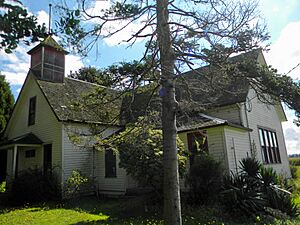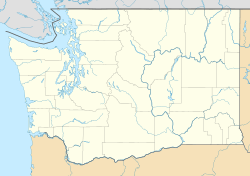Skagit City, Washington facts for kids
Quick facts for kids
Skagit City, Washington
|
|
|---|---|

Skagit City School, one of the few remnants of Skagit City. Photographed, 2013
|
|
| Country | United States |
| State | Washington |
| County | Skagit |
| Settled | 1868 |
| Time zone | UTC-8 (Pacific (PST)) |
| • Summer (DST) | UTC-7 (PDT) |
Skagit City was once a busy town in the state of Washington. It was located on the western side of the South Fork Skagit River. This town was very important for river travel in the late 1800s. It grew quickly after Barker's Trading Post opened in 1869.
Skagit City was a thriving place until the late 1870s. That's when ships could finally travel further upriver to Mount Vernon, Washington. After that, Mount Vernon became more important, and Skagit City slowly faded away. By 1906, almost all businesses were gone. The town completely disappeared after World War II. Today, "Skagit City" is just a name for a spot on Fir Island. The nearby community of Cedardale is the closest town to where Skagit City used to be.
How Skagit City Started
The first white settlers arrived in the Skagit River area in 1868. A man named John Campbell set up a small trading post. Then, in 1869, John Barker opened Barker's Trading Post. This trading post was near where the Skagit River splits into two parts: the North Fork and the South Fork.
The South Fork was easy for boats to use. But the North Fork was smaller and flowed into marshy areas. Huge logjams, which were like giant piles of logs, blocked the river further upstream. These logjams stopped boats from going past Skagit City. This meant all river traffic had to stop at the trading post. This helped Skagit City grow. Later, these logjams were removed, which allowed boats to go further upriver. This was a big reason why Skagit City eventually declined.
Early Challenges
Around 1869 or 1870, something sad happened. John Barker, who owned the trading post, was killed. At first, some Native Americans were wrongly blamed. But later, it was found that a white man had likely committed the crime. The person suspected, Quimby Clark, left the area before he could be questioned.
Another interesting story involves John Campbell. In 1874, he was on a canoe trip up the Skagit River. One night, he disappeared into the forest. Later, his group heard loud screams. It turned out to be Campbell, shouting the name of a local Skagit River Indian. People thought he might have been very confused. He was eventually tricked into returning to Skagit City.
Skagit City's Peak Years
Around 1872, Skagit City was at its busiest. It had a safe harbor for large boats called sternwheelers. These boats traveled from Seattle to smaller towns in the southern Puget Sound. The Fanny Lake was a famous sternwheeler. It was about 100-foot (30 m) long and helped a lot with settling the Skagit Forks area, including Skagit City.
The Fanny Lake started its route around 1874. It helped bring many new settlers to the valley. Sadly, the ship sank in 1883 after hitting a shallow part of the river. But it was fixed and put back into service in 1889 by Joshua Green and his partners. For the next ten years, the Fanny Lake helped the Skagit Forks area grow very quickly.
Skagit City was a typical "river town." It was long and narrow, built along a levee next to the Skagit River. Businesses faced the river. Many boats, including a ferry, docked in Skagit City's large harbor. At its best, the town had many shops, houses, a church, hotels, a school, and a saloon. The Fanny Lake also carried farm products like grain and hay. In 1893, the Fanny Lake was destroyed for good when it caught fire and sank.
Why Skagit City Disappeared
Skagit City began to decline in the 1870s. This happened when the huge logjams blocking the Skagit River were finally removed. These logjams had stopped boats from going further upstream. Once they were gone, the town of Mount Vernon, Washington, which was upstream, could grow and become more important.
The work to remove the logjams, known as the Skagit Jam, started in 1874. General Michler of the U.S. Army Corps of Engineers studied how to clear the river. The logjams were about 2 miles (3.2 km) long. They were very wide and deep, with logs packed tightly together. There was even mud and sand on top of the logs, with trees growing on them!
...the lower jam, a channel had to be cut one-fourth of a mile long, through logs wedged in as tightly as possibly for water to wedge them, from the bottom of the river to the surface, and many 20 feet above the surface, and from bank to bank; with mud and sand in many places on the surface of the jam ten feet deep, and trees growing on it ten inches in diameter. They had to slash and [unreadable] the forest of young trees on the jam, before they could commence sawing and getting out he logs and rubbish of the jam proper.
Then when all the logs on the surface were sawed off and rolled into the water some six successive layers would rise to the surface that had to be treated in a similar manner. In this way a channel one hundred and fifty to two hundred feet wide was cut through solid mass of logs averaging from 30 to 40 feet high for one-fourth of a mile long. This part of the work, the removal of the lower jam, was finished in September 1876, since which time the town of Mt. Vernon and several logging camps have sprung into existence above it.
Between the main jams were sufficient obstacles to require nearly one quarter of a mile of cutting before the upper jam was really reached; this took until March 1877. This part left in a body, blocking up the courses of the river, so that steamers could not enter until it was removed, which took about two months of their time.
Work on the upper jam was commenced in May 1877. In clearing the lower river, five or six men had been employed for a short time so as to interfere as little as possible with its navigation. That is nearly all the extra help ever employed.
-Eldridge Morse, The Northern Star, 12 June 1878
By late 1877, the logjams were completely gone. This allowed boats to travel freely upriver. Mount Vernon, about 3 miles (4.8 km) upstream from Skagit City, started to grow rapidly. Skagit City, on the other hand, slowly lost its businesses and people to Mount Vernon. By 1906, only one general store was left in Skagit City. It closed in the early 1910s.
Skagit City Today
Even though Skagit City faded away, the area still needed a school. In the 1880s, many new settlers came to the northern part of Fir Island. Before the Skagit City school was built, children walked to other schools nearby.
After a flood in 1887 damaged one of the schools, a new school district was created. The Skagit City District 57 School was built in 1888. It was on higher ground, a bit north of the old school. But in 1901, floodwaters damaged this new school too. So, families chose a new location on even higher ground, further away from the river.
The old Skagit City School building still stands today at 1552 Moore Road. It served the area from 1902 to 1940. Someone bought the building and property in 1943.
See also
 In Spanish: Skagit City (Washington) para niños
In Spanish: Skagit City (Washington) para niños



